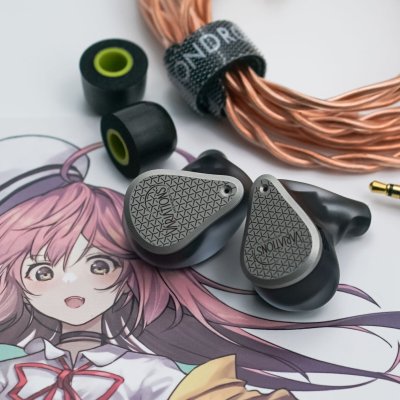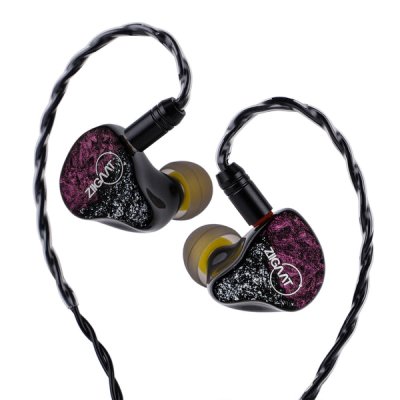Moondrop Variations and Ziigaat Odyssey use 1DD+2BA+2EST and 1DD+3BA driver setups respectively. Moondrop Variations costs $550 while Ziigaat Odyssey costs $229. Moondrop Variations is $321 more expensive. Ziigaat Odyssey holds a slight 0.3-point edge in reviewer scores (7.5 vs 7.8). User ratings place Moondrop Variations at 7.5 and Ziigaat Odyssey at 7.4. Ziigaat Odyssey has slightly better bass with a 0.3-point edge, Ziigaat Odyssey has significantly better mids with a 1-point edge, Ziigaat Odyssey has significantly better dynamics with a 1.1-point edge and Moondrop Variations has slightly better soundstage with a 0.3-point edge.
Insights
| Metric | Moondrop Variations | Ziigaat Odyssey |
|---|---|---|
| Bass | 7.3 | 7.6 |
| Mids | 7.1 | 8.1 |
| Treble | 7.5 | 7.4 |
| Details | 7.3 | 7.2 |
| Soundstage | 7.8 | 7.5 |
| Imaging | 7 | 7.8 |
| Dynamics | 6.2 | 7.3 |
| Tonality | 7.4 | 7.8 |
| Technicalities | 7.6 | 7.1 |
Moondrop Variations Aggregated Review Score
Average Reviewer Scores
Average Reviewer Score:
7.5Generally Favorable
Ziigaat Odyssey Aggregated Review Score
Average Reviewer Scores
Average Reviewer Score:
7.8Strongly Favorable
Reviews Comparison
Moondrop Variations reviewed by Jaytiss
Youtube Video Summary
Build & accessories: Variations shows its age. The resin shell fits well and the metal faceplate looks clean, but the body feels a bit chintzy and slightly see-through, with a chunky nozzle compared to newer slim designs. The pocketable case is nice, yet the stock cable is thin with barely visible L/R markers; modular termination is handy, but modern Q-Lock-style systems do it better.
Sound: tuning centers on energetic, engaging vocals with a tasteful sub-bass lift—not a bass-head set, more a polite, gradual boost. A dip around the lower mids can read as thinness, pushing some female vocals a touch distant, while the top end has air, detail, and an overall chill presentation. Technicalities are solid rather than class-leading at the price, but the EST implementation is clean and cohesive. Expect limited mid-bass weight, occasional shout for the sensitive, and ergonomics that won’t suit everyone.
Context & verdict: despite a wave of competitors (Oracle MK2, Hype 4, Softears Studio 4/Volume S, AFUL Performer 7, DUNU Brain Dance, even Moondrop’s own Dusk at a lower price), this tuning remains a benchmark reference around the mid-fi bracket. Variations delivers the archetype many listeners still chase: clean sub-bass, airy treble, and a deft, easygoing balance that makes it a “legendary” set in the catalog. Not flawless, but noteworthy—the kind of IEM worth borrowing at a meet and auditioning for 10–15 minutes to see if that lighter midrange flavor clicks.
Jaytiss Youtube Channel
Buy Moondrop Variations on HiFiGO
Ad
Price: $479
Buy Moondrop Variations on HiFiGO
Ziigaat Odyssey reviewed by Jaytiss
Youtube Video Summary
Single-DD + 3BA hybrid with a clean, confident look: thick shell, metal nozzle that grips tips well, visible rear vent, and the preferable flat 2-pin connector. The standard Ziigaat case feels premium if a bit unexciting. Sonically, Odyssey lands a balanced, tastefully energetic tuning—ample bass for most listeners, elevated upper mids for presence, and a smooth, clean upper-treble. Out of the box it sounds immediately right and counts among the better-tuned sub-$300 IEMs. The catch: macro/micro detail and imaging are good, not mind-blowing, keeping overall technical performance at “appropriate for the price.”
Within Ziigaat’s lineup, Arcadia skews darker with less treble reach, Xeno/Ceno feels a bit treble-shy, and Dinko is the more V-shaped, poppier pick with extra sub-bass. Explorer overlaps in tonality but Odyssey adds more upper-mids energy and refinement—albeit at a higher price. Among peers, AFUL’s P7 brings the stronger technicals and a slightly more neutral sheen, K4 trades blows, and “Quattro” may edge tuning purity. As an all-rounder, though, Odyssey hits a sweet spot: rich mids, fun but controlled bass, convincing note weight, and a natural stage, even if the far-upper air can temper ultimate sparkle.
Verdict: a fantastic mid-tier set with high price-to-performance, gorgeous faceplates, and a crowd-pleasing tonality; accessories are a bit underwhelming, and the top-end “air” won’t wow technicality chasers. Scored around 8.8/10 and easily recommended as a safe, musical choice—especially when discounts bring the sticker down.
Jaytiss Youtube Channel
Buy Ziigaat Odyssey on Linsoul
Ad
Price: $229
Buy Ziigaat Odyssey on Linsoul
Moondrop Variations reviewed by Gizaudio Axel
Gizaudio Axel original ranking
Gizaudio Axel Youtube ChannelZiigaat Odyssey reviewed by Gizaudio Axel
Gizaudio Axel original ranking
Gizaudio Axel Youtube ChannelMoondrop Variations reviewed by Jays Audio
Youtube Video Summary
Moondrop Variations tracks the compensated diffuse-field target closely at typical listening levels (75–85 dB), delivering a signature that is clean, smooth, airy with center-locked imaging. The well-known mid-bass tuck trades some weight on male vocals, bass guitars, and kick drums for top-tier separation and midrange clarity, while the sub-bass rises with a subwoofer-like rumble and texture. Treble is generally coherent and extended, though a touch of extra energy past 12 kHz can turn hot on brighter J-/K-Pop masters. At sane volumes, the overall presentation feels correct and harmonious, with instruments and vocals popping out in a spacious, non-congested stage.
Against Blessing 2 Dusk, Variations sounds clearer and more separated with better sub-bass extension; Dusk’s added mid-bass gives male vocals more heft but softens the subwoofer illusion and feels less smooth up top, making female vocals a bit less airy. For listeners wanting a touch more slam and a gentler treble tilt, sets like Shuoer EJ07M and the original Monarch provide that extra meat without wrecking clarity. On a budget, the Moondrop Quarks DSP offers a “mini-Variations” vibe—~85% of the experience—though it gives up some treble extension, bass texture, and imaging precision due to driver and DSP constraints.
Big picture: for accuracy, balance, imaging, and an almost studio-monitor take in an IEM, Variations remains a go-to recommendation—especially if there’s no strong preference for extra mid-bass or if listening stays below 85 dB. Those chasing more bite or “out-of-the-box” coloration can find sharper sets, but they won’t sound as even, faithful, or effortlessly clear as Variations at moderate volumes.
Jays Audio Youtube Channel
Ziigaat Odyssey reviewed by Jays Audio
Youtube Video Summary
Ziigaat Odyssey lands as a mid-range focused set with a slight treble lift that really scales with volume. At relaxed levels it’s clean, calm, and easygoing; turn it up and the presentation becomes wide, airy, and immersive with a surprisingly punchy, rumbly low end for its graph. The new topology DD hits a sweet balance—neither sluggish nor hyper-snappy—delivering well-balanced bass that serves the tuning, even if ultimate slam/texture trails sets like Hype 4 or Xenns Tea Pros. Tip rolling toward slightly brighter tips adds a touch of treble energy and liveliness without pushing fatigue.
The star here is the midrange: instruments layer neatly with comfortable separation, and vocals sit clean and natural—not shouty, not veiled—though they can feel a bit too relaxed at mid volume. Treble is smooth yet detailed, revealing cymbal micro-info and air without harshness, and it’s noticeably cleaner than Explorer while avoiding metallic timbre. Technicals are solid for the price—a step up from Explorer and just behind “contet” in raw resolving power—yet more natural in timbre and notably more musical when driven louder. The tuning flatters slow rock, acoustic, indie, alternative, and ballads, where the Odyssey’s “turn-it-up” character shines.
For alternatives: those wanting warmer, bassier impact for hip-hop, rock, or metal may prefer Kiwi Ears K4, HBB Arcadia, or the Deuce for true bass-head needs. For mid-volume all-rounders with more instant engagement and technical pop, consider Supermix 4, Nova, Quintet, or Chopin; for airier, brighter takes with sweeter female vocals, look at Cadenza 4 or CKLVX. As a package, Odyssey feels like a future classic—gorgeous plating, a cable that could use an upgrade, and a uniquely immersive, high-volume experience that invites shutting out the world and sinking into the music.
Jays Audio Youtube Channel
Moondrop Variations reviewed by Tim Tuned
Youtube Video Summary
Packaging brings typical Moondrop flair—an anime-clad box, a large but well-built carrying case, assorted foam and silicone tips, and interchangeable plugs (3.5/2.5/4.4). The shells look sleek and minimalist, with a stock cable that’s better than usual for the brand. Fit mirrors the Blessing 2 profile—still on the larger side—but slightly more comfortable over long sessions.
Sonically, this is a sub-bass focused set with minimal mid-bass, yielding deep, clean rumble and zero bleed. The midrange is refined and clear, giving female vocals spotlight treatment, while male vocals can feel a touch thin due to the leaner lower mids. Treble is well-extended with a hint of air, avoiding peaks, sibilance, and fatigue. The headline is separation and microdetail—attack/decay snap notes into place so instruments occupy distinct spaces, producing imaging that’s confident and a stage that’s wide enough for the price.
Against $500 peers like Kiwi Ears Orchestra and Thieaudio Oracle, Variations competes directly; Oracle may sound warmer and more natural on male vocals, but Variations pushes ahead with cleaner layering and a more modern, sub-bass fun tilt. At around $530, it delivers a taste of $1k-class resolution without sacrificing musicality—an easy five-star recommendation for listeners who want clarity, air, and subterranean slam over extra mid-bass warmth.
Tim Tuned Youtube Channel
Ziigaat Odyssey reviewed by Tim Tuned
Youtube Video Summary
Ziigaat Odyssey takes the new Meta tuning and gives it a more V-shaped, exciting twist. It keeps the beautiful mid-range intact while adding extra energy to both bass and treble, landing closer in spirit to Moondrop x Crinacle Dust (DSP) and Kiwi Ears K4—but with more swagger. It’s not as strictly on-target as those sets, yet the result is more engaging and solves the “too safe, sometimes boring” side effect of many Meta-tuned IEMs.
Beyond tuning, Odyssey brings real upgrades in technical performance for the price. Bass dynamics are punchier and more well-defined than K4, and treble nuances come through with greater clarity while preserving that natural vocal center. At $229, it undercuts many competitors and still feels like a step up—an easy pick for listeners who want Meta’s mid clarity with extra excitement and better slam without sacrificing coherence or comfort.
Tim Tuned Youtube Channel
Moondrop Variations reviewed by Head-Fi.org
Ziigaat Odyssey reviewed by Head-Fi.org
Moondrop Variations (more reviews)
Moondrop Variations reviewed by Super* Review
Youtube Video Summary
Moondrop Variations enters the $520 bracket as a sleek tribrid (DD bass, BA mids, dual EST treble) that mirrors the Blessing 2 shell and fit—complete with the familiar large nozzle—while upgrading the look with a smoky, beach-glass finish. The package is generous (tips, foams, spare filters, and a modular cable with 3.5/4.4/2.5 swaps), though the case is bulky and the connector mechanism isn’t the slickest. Ergonomics are essentially the same as Blessing 2/Dusk; secure once sealed, but best with smaller tips.
Sonically, this reads as a refined “Dusk-plus”: a flatter lower-mid profile, prominent yet tidy sub-bass, and treble that’s a touch smoother and better extended than Blessing 2/Dusk. Despite measuring with more sub-bass than Dusk, it often feels less bassy in practice—more integrated, less showy—while preserving the line’s standout midrange detail and vocal clarity. Versus peers, staging depth benefits from the sub-bass lift (a hair more “space” than Blessing 2), and detail/resolution is effectively on par with Dusk; Blessing 2 still edges it for midrange naturalness, and all-BA sets like S8 retain the treble finesse crown.
The catch is value: performance moves forward, but only by small, picky margins. With Blessing 2/Dusk sitting a full $200 lower, Variations feels like a tasteful refinement rather than a categorical leap. For listeners who want a neutral core with an articulate sub-bass emphasis and slightly more air/polish up top than the Blessings—without the Dusk’s heavier bass feel—it’s an excellent pick. As scored, it earns 4 stars: easy to recommend on its tuning and competence, just shy of “must-buy” given how close its cheaper siblings perform.
Super* Review original ranking
Super* Review Youtube ChannelMoondrop Variations reviewed by Crin
Crin Youtube Channel
Moondrop Variations reviewed by Kois Archive
Kois Archive Youtube Channel
Moondrop Variations reviewed by Shuwa-T
Moondrop Variations reviewed by Smirk Audio
Moondrop Variations reviewed by Audionotions
Moondrop Variations reviewed by Precogvision
Youtube Video Summary
Moondrop Variations takes the Harman idea and fixes what that target often gets wrong. The tuning pushes sub-bass with minimal mid-bass, plus a dip around ~200Hz that cleanly separates lows from the rest—think speaker rig with a dedicated sub. Midrange is clear yet forward, bordering on shouty in noisy environments, with thinner lower-mid body. Treble is the standout: a smooth, extended EST implementation with real air to ~15kHz—softer in attack than some sets, but among the few EST tunings that actually feel coherent at this price. Build echoes Blessing 2’s large shell, fit is good for larger ears, and the cable’s swappable termination is a practical upgrade.
Technical performance is where Variations surprises. Detail retrieval is top-tier for ~$520, edging past well-known mid-fi competitors and clearly a step up from the Blessing line; imaging is solid if not showy, while dynamic contrast and punch are unusually engaging. Bass quality shows better texture and slam than earlier Moondrops, even if the absolute best DD bass in class still belongs elsewhere. The overall presentation is energetic, clean, and high-contrast—notes pop against a dark low end and lit upper mids/treble.
Against peers, DUNU SA6 suits listeners wanting smoother, laid-back treble and a less insistent midrange, whereas Shuoer EJ07M offers a bouncier bass shelf but a less even top end. Compared with Moondrop’s own Blessing 2/Dusk, think “Dusk on steroids”: bigger sub-bass, more resolution, and more punch—though Dusk owners won’t see a night-and-day jump. Imperfections aside, on paper this is one of the most complete packages in its bracket, especially for those who value sub-bass authority, clarity, and a refined EST treble without sacrificing coherence.
Precogvision Youtube Channel
Moondrop Variations reviewed by Nymz
Moondrop Variations reviewed by Yifang
Ziigaat Odyssey (more reviews)
Ziigaat Odyssey reviewed by Bad Guy Good Audio
Bad Guy Good Audio original ranking
Bad Guy Good Audio Youtube ChannelZiigaat Odyssey reviewed by Audio Amigo
Youtube Video Summary
Ziigaat Odyssey comes in at $230 with a four-driver hybrid (1DD + 3 BAs) that’s very easy to drive. Build is the usual Ziigaat: full 3D-printed resin shells with metal nozzles and filters; sturdy and comfortable for average-to-larger ears, while tiny ears get a technical pass. The weak spot is the accessories: a basic cable (3.5mm or 4.4 option), one set of soft silicone tips plus foams, and a leatherette case that feels flimsy—underwhelming at this price. Aesthetics score well with a sparkly faceplate that the “Council of Ladies” mostly favors, even if it doesn’t always trigger compliments.
Sonically, Odyssey aims for warm-neutral with a tasteful bass boost. Sub-bass texture can run a touch soft, but mid-bass punch is addicting, giving kick drums and bass guitars real drive without boom. Lower mids are warm and slightly veiled in a pleasant, retro-leaning way; female vocals sit a bit back yet remain clean. Treble is safe but present—enough sparkle and clarity to balance the bass without sting, though true treble-heads may want more air. Technicals are solid for the bracket: good resolution, excellent separation, precise imaging, and an average-sized but convincing stage. With a 15–30Ω adapter, the FR tilts more V-shaped (more bass/upper-mids/treble), a fun twist for occasional variety.
Against peers, Odyssey is the relaxed, safer listen: warmer and less contrasty than EPZ P50 (brighter, more vocal-forward) and Kiwi Ears K4 (more V-shaped excitement), and a middle ground between AFUL Explorer (darker, bassier) and AFUL Performer 5+2 (airier, more resolving with stronger female vocals). Not the pick for bass-heads, treble-heads, or libraries packed with K-/J-pop divas, but a killer one-and-done all-rounder for mixed libraries that value warmth, balance, and zero fatigue. Despite the skimpy pack-ins, the tuning and performance earn a spot in “this is brilliant.”
Audio Amigo Youtube Channel
Ziigaat Odyssey reviewed by Paul Wasabii
Youtube Video Summary
A slow-burn hybrid (1DD + 3BA) around $200 that has grown by word of mouth. Tuning is Goldilocks—smoother/warm lower end with a tidier, slightly lifted upper end—making it broadly natural and low-fatigue across libraries. Impedance interaction matters: low-impedance sources keep a fuller mid-bass and flatter ~5 kHz, while added impedance nudges sub-bass and a little 5 kHz bite for a more U-shaped tilt. It doesn’t chase max technicalities, instead prioritizing musicality and tone.
Bass leans mid-bass over pure sub-bass, bringing welcome physicality and punch without boom; the custom DD feels lively. Mids are clean yet set a hair behind bass/treble, so transparency and headline resolution trail leaner micoplanar-leaning rivals, but timbre stays convincing and unfussy. Treble rides the line—polished and slightly elevated to balance the low end, with potential ~5 kHz energy on higher-impedance chains—still more smooth than sharp. Stage, depth and air are as expected for the class, yielding a coherent, well-balanced presentation that explains its long-tail appeal.
Paul Wasabii Youtube Channel
Ziigaat Odyssey reviewed by
 Fresh Reviews
Fresh Reviews
Youtube Video Summary
Ziigaat’s 2024 lineup lands three distinct flavors: the R (1DD+4BA), Arcadia (1DD+2BA), and Odyssey (1DD+3BA)—all sharing the same case, tips, and cable, but with very different tunings and striking faceplates. Pricing lives in the approachable range (roughly $200–$250), and the shells are well-built 3D-printed resin. The Odyssey’s nozzle appears slightly wider than the R’s, and its cloudy pink/silver faceplate looks clean and premium without the flashiness of Arcadia’s green/yellow sparkle.
For competitive play, title-by-title differences matter. In Valorant, Arcadia’s extra warmth and bass impact feel immersive but a touch boomy/bloomy under heavy ability spam—solid, around a B. The R and Odyssey perform on par with high marks; the R’s 1–3 kHz lift sharpens clarity and verticality, while Odyssey is more neutral and less bright. In Apex Legends, Arcadia struggles as bass bloom masks micro-cues (B–/C+). Odyssey delivers great separation/layering with slightly softer overhead cues (B+/B), and handles gunfire more comfortably than the R. In CS2, Odyssey takes the lead for its imaging, depth perception, and non-fatiguing balance; in Warzone, the order shifts to R > Arcadia > Odyssey, with Arcadia’s warmth helping vertical reads and impact.
As a music set, the Odyssey is a standout: potent, tight bass with clean transients, balanced mids that aren’t smothered, and a clean, non-sibilant treble that avoids fatigue while letting micro-detail through. It lands as a favorite in its price bracket—an easy recommendation for listeners who want a neutral-leaning all-rounder that still punches hard, splits cues well, and won’t scorch ears with gunfire or treble glare.
Fresh Reviews original ranking
Fresh Reviews Youtube ChannelZiigaat Odyssey reviewed by Web Search
The Ziigaat Odyssey offers a balanced take on the popular Meta tuning, emphasizing sub-bass rumble while maintaining a clean midrange. Its bass provides satisfying depth without bleeding into the mids, making genres like electronic or hip-hop engaging. Vocals come through clearly and naturally, though some listeners might find them lacking a touch of emotional expressiveness or "magic" compared to more specialized sets . The treble is generally smooth and inoffensive, avoiding harshness but sacrificing some sparkle and micro-detail retrieval .
Technically, the Odyssey presents a wider-than-average soundstage, though depth and height are more modest. Instrument separation handles moderately complex tracks competently but can struggle with dense passages. Its strength lies in its cohesive driver integration and natural timbre, minimizing typical BA artifacts . Comfort is good for most despite the resin shells, but isolation is average due to the venting design. The included accessories, particularly the stiff silicone tips and non-modular cable, are weak points for the price .
Overall, the Odyssey is a versatile performer prioritizing enjoyable tonality and listenability over technical brilliance. It's an easy recommendation for those seeking a well-tuned, non-fatiguing hybrid around $200, especially if tip rolling is employed. However, detail enthusiasts or those needing maximum isolation might look elsewhere .
Moondrop Variations Details
Driver Configuration: 1DD+2BA+2EST
Tuning Type: U-Shaped
Brand: Moondrop Top Moondrop IEMs
Price (Msrp): $550
Support our free service! Buying through our affiliate links costs you nothing extra:
Ziigaat Odyssey Details
Driver Configuration: 1DD+3BA
Tuning Type: Neutral with Bass Boost
Brand: ZiiGaat Top ZiiGaat IEMs
Price (Msrp): $229
Support our free service! Buying through our affiliate links costs you nothing extra:
Moondrop Variations User Review Score
Average User Scores
Average User Score:
Based on 2 user reviews
7.5Strongly Favorable
Ziigaat Odyssey User Review Score
Average User Scores
Average User Score:
Based on 2 user reviews
7.4Generally Favorable
Moondrop Variations Gaming Score

Gaming Score & Grade
- The gaming score is prioritizing technical capabilities of the IEM (Separation, Layering, Soundstage) and good value.
Gaming Score
7.1Gaming Grade
A-Ziigaat Odyssey Gaming Score

Gaming Score & Grade
- The gaming score is prioritizing technical capabilities of the IEM (Separation, Layering, Soundstage) and good value.
Gaming Score
7.5Gaming Grade
AMoondrop Variations Scorings
Average Technical & Tuning Grades
Average Tunign Grade
A-- It balances warmth and clarity well, showing only minor quirks along the way. Timbre feels believable with most instruments.
Average Technical Grade
A- It delivers a confident technical showing with defined layers and satisfying clarity. You can follow backing vocals with relative ease.
Ziigaat Odyssey Scorings
Average Technical & Tuning Grades
Average Tunign Grade
A- You get a polished tonal profile that stays natural from bass through treble. Subtle tuning choices keep things engaging.
Average Technical Grade
A-- A competent technical showing keeps separation intact while delivering modest staging. It feels tidy even when recordings stack layers.
Moondrop Variations User Reviews
Share your experience and build your personal ranking list.
You need to be signed in to write your own reviewTaught me Harman is not for me...
Pros
Clean and clearCons
Recessed lower mids, a bit too calm and lifelessThis was one of my first IEMs. I loved it and hated it. It is still the cleanest sounding IEM I own - also compared to something much more expensive.
Pros
Very clean sound signature combined with a satisfying amount of sub-bass. Sounds great with the right songsCons
Thin mids and poor note weight in some songsZiigaat Odyssey User Reviews
Share your experience and build your personal ranking list.
You need to be signed in to write your own reviewVery pleasing to listen to. A good starter mid-fi set that seems to cater towards neutrality while decently technical. Sibilance at higher volumes in the 6-8khz region. Good for gaming, but can get convoluted at times.
Pros
Extremely smooth mids. Bass response is very clean, and doesn't bleed into the mids much.Cons
Strange sibilance in the 6-8khz region, easy fix with eq. Doesn't seem to have very good treble extension. The recessed 1.5-2khz region causes vocals to sound distant - can be good depending on preferences.It's an easy recommendation. The tuning is great. Tech is okay, but nothing special
Pros
Fun but still "accurate" sounding signature. Comfy shell with nice design.Cons
The cable requests to be replaced. Nothing special in terms of technicalities.Find your next IEM:
IEM Finder Quiz
newIEM Comparison Tool
newVS



































